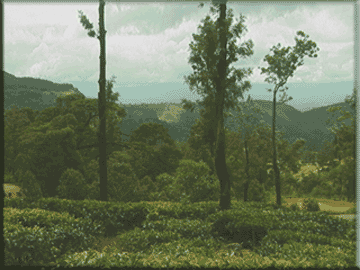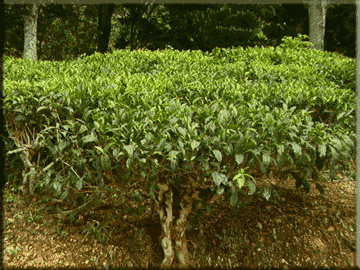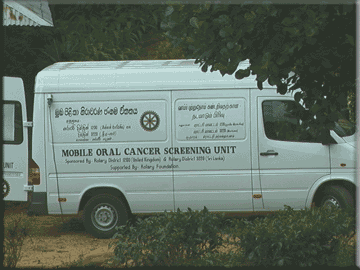Sri Lanka - An oral cancer screening project in tea estates
Sri Lanka - An oral cancer screening project in tea estates
Introduction
Staff of the Department of Oral Medicine, Faculty of Dental Sciences, University of Peradeniya has been conducting an Oral Cancer Screening Programme in the Kandy area, since 1998. This presentation is based on information and pictures collected by Ms. Elisabeth Holmqvist and Ms. Sara Colliander, two dental students from the Dental Faculty, Malmo, Sweden who were visiting the Dental Faculty in Sri Lanka and had the opportunity to accompany the Screening Team on one of their visits to a tea estate. We thank Dr V Vijayakumaran and Dr Anura Ariyawardana, for their contribution to this presentation.

An up-country tea estate
Background and Rationale
Oral cancer is the commonest form of cancer in adults in Sri Lanka. Screening of the oral cavity for oral cancer and oral precancer is a simple and cost effective method to prevent and detect this disease early. Tea estate workers have been identified as a high oral cancer risk group and were targeted for screening. The Oral Cancer Screening Project was started in 1998 with the financial support from the Rotary International and was successfully completed in two years. It was considered important to continue the project in order to cover the other tea estates in the area that were not included during the first project. Presently, the cancer Screening Team of the Faculty with some volunteer dentists run the screening programme in parallel with a project funded by the Plan International, which provides dental care for children in rural areas of Sri Lanka.

A typical tea bush
Project Outline
Local health care workers and estate medical officers were trained at the Faculty of Dental Sciences by the Expert Group on Oral Cancer Screening at the Faculty of Dental Sciences, Peradeniya for two days in the detection of oral mucosal lesions. The initial screening is carried out while the health care workers do their regular examinations, usually during house calls. All subjects above 40 years of age were examined for oral lesions. The care workers classify the lesions into three stages,
Stage 1. Lesion for observation
- Homogeneous leukoplakia
- Ulcerated leaukoplakia
Stage 2. Lesion for investigation
- Speckled/nodular leukoplakia
- Erythroplakia
- Oral submucous fibrosis
Stage 3. Cancer probable or already treated for cancer
- Overt oral carcionoma
- Treated cancer
Those patients who received a primary diagnosis of stages 1-3 are asked to come for further investigation.
The Screening Team from the Dental Faculty participates in the next step by visiting the tea estate in a vehicle equipped with a dental unit donated by Rotary International. A second examination is performed by on the individuals with primary diagnosis of stages 1-3 and when necessary those patients who need further investigation or treatment are asked to come to the Dental Hospital, Peradeniya.
Usually an average of 25 pre-screened individuals are seen by the Screening Team on a single visit to the tea estate. Furthermore, any other mucosal lesions excluding pre cancer and cancer also are investigated where appropriate. Treatment for such problems are initiated if necessary.
From February 1999 to September 1999 a total of 73 tea estates in the central region of Sri Lanka were visited by the team. A total of 12,716 subjects were screened initially by the estate health care officers of which the team screened 1,478 individuals who were found to be positive by the health care workers and 659 patients were identified as positive cases by the team.

The mobile screening unit
Constraints to the Project
Only 50% of the patients screened this way however continue the investigations after the primary diagnosis. This perhaps is due to fear of treatment and lack of knowledge of the seriousness of their disease. In addition, many of the patients are too poor and cannot afford missing the income for a days work, or pay for the trip to the Dental Faculty. For instance, the time when the two Swedish dental students participated in this project, of the 16 patients examined 5 were asked to come to the Dental Faculty for further investigation. None came on the first appointment, but when the doctors arranged for a bus to take the patients to Peradeniya where the Faculty is situated, four patients came and biopsies were taken.

Lining for examination where dentists treat patients, for the Plan International project
Conclusion
Screening of high risk groups for oral cancer is a relatively simple procedure and could be undertaken by every dentist and health care worker in every day clinical situation or during house visits.
Link to: ART explanation
